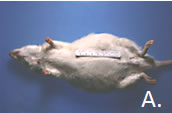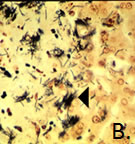Etiology: Clostridium piliforme is a Gram-negative, obligate intracellular rod that produces spores.
Incidence: Incidence of disease is rare in the rat.
Transmission: Infection is established via the fecal-oral route by ingestion of spores. Predisposing factors to disease include age (commonly 3 to 7 weeks) and physiological stresses such as concurrent infections, experimental manipulations, or poor housing conditions.
Clinical Signs: Subclinical infection is the most common form of infection in the rat. Clinical manifestations of Tyzzer’s disease include anorexia, hunched posture, distended abdomen (A.), rough hair coat and death.

Pathology: A “fat rat” syndrome with a flaccid segmental dilatation of the intestine (especially of the ileum) has been described. The liver typically has multiple pale foci throughout. Circumscribed, greyish foci may sometimes be observed in the myocardium. Histologically, multiple necrotic foci in sections of liver and myocardium are often surrounded by a pyogranulomatous cellular infiltrate. Silver stains (Steiner or Warthin-Starry) will help delineate the bacterium (arrowhead, B.), which can be observed within the cytoplasm of viable cells bordering the necrotic foci.

Diagnosis: Serological assays (MFI, IFA) and PCR (on cecum or feces) can be used to identify C. piliforme infected rats. Diagnosis can be confirmed histologically by demonstration of the bacillus in the enterocytes, hepatocytes or cardiac myocytes bordering necrotic foci in tissues stained with silver stains.